The Porsche Taycan Turbo S Chases the Wrong Goals
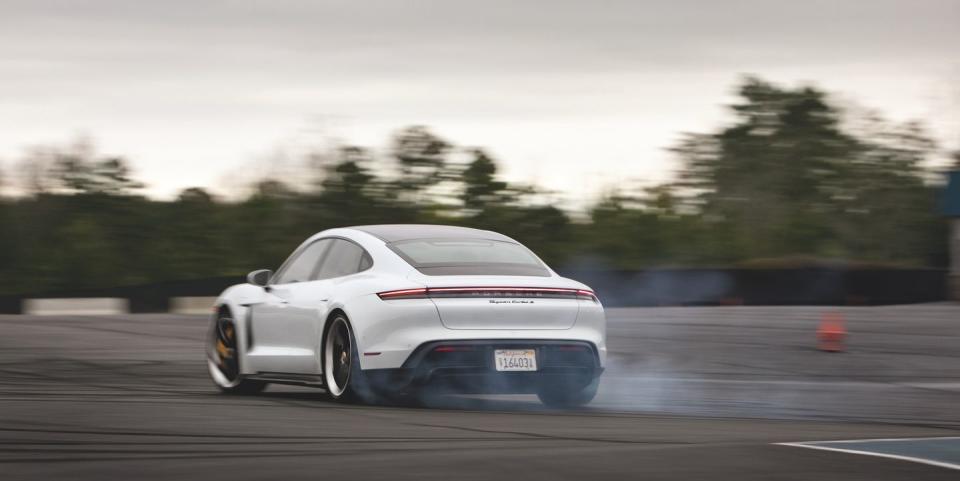
It was 2013. R&T had just completed its first review of the new Tesla Model S Performance (April ’13 issue), photographing the car with a group of pastel-colored Fifties American sleds. “The last time the world was in awe of an American car,” the review said, “it had fins.”
This story originally appeared in the March/April 2020 issue of Road & Track.
If I remember those words, it’s because I wrote them. And a week after that story saw print, I happened to be on a test drive in Europe with a group of Porsche engineers. Proud of the issue, I pulled it out of my bag and passed it around. People say Germans have no sense of humor, but the Swabians couldn’t contain their laughter. Nor did they realize that I had written the review.
“Nobody vill buy zis stupid car,” one cackled. “It’s a complete joke!”
The punchline, of course, is that Teslas are now as common as kale in every well-to-do coastal town in America. Now the most valuable American carmaker of all time, Tesla is worth more to Wall Street than Ford and GM combined. The brand’s recent market cap of just over $101 billion puts it above the entire Volkswagen Group, which includes those Porsche engineers. Plus Bugatti. And Lamborghini. And Bentley. And Audi. And Volkswagen. And six other successful brands.
Stuttgart’s snickering stopped dead in the midst of VW’s Dieselgate fiasco—a sober moment in automotive history, but one that will likely wind up being a blessing for the Volkswagen Group. While the rest of the industry sits paralyzed, fearing the electric future, Dieselgate forced VW to pivot R&D toward electric cars. The Porsche Taycan Turbo S is among the first of many offspring to come from that foresight.
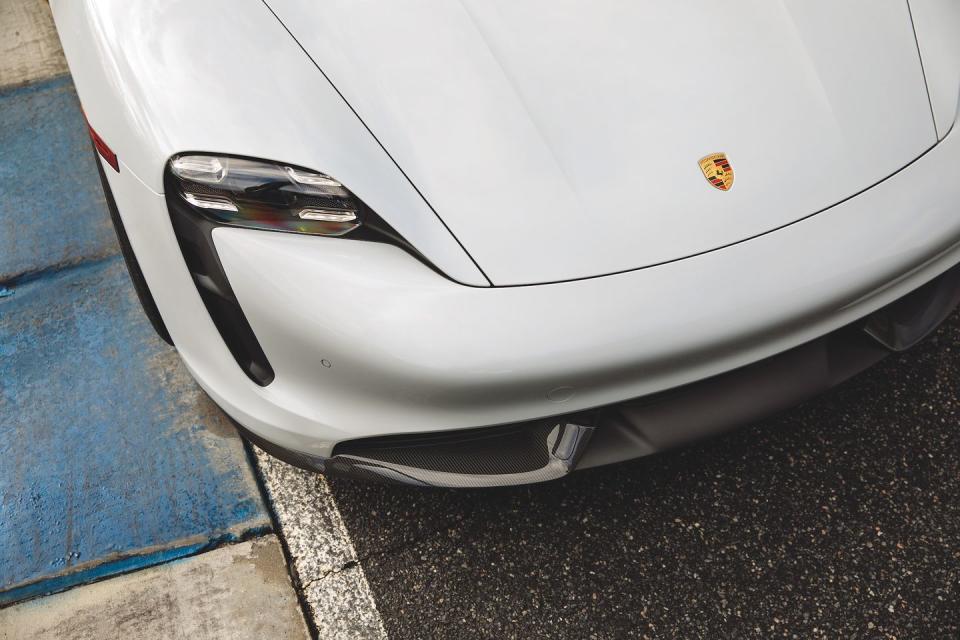
It’s also a missile fired directly at Silicon Valley. There’s no going back to internal combustion once you’ve lived with an EV, and the Tesla Model S is growing old, now in its ninth model year.
It’s no surprise, then, that the Taycan’s length and width are only a fraction of an inch off those of a Model S. The key difference is that the Porsche was built by a company with decades more experience in screwing cars together. Its aluminum panels line up perfectly, with small and even gaps, and the paint is flawless, even on our preproduction test car. The Taycan’s austere, four-seat cabin is somewhat tight but beautifully designed and executed, snugly fitted with nary a rattle or squeak. The only hitch lies in the fact that neither the materials nor the design reflect the car’s $200,000 price—a legacy of the base Taycan’s sticker, which is roughly $100,000 less.
The Turbo S sits at the top of the Taycan lineup, 750 hp and 774 lb-ft from two motors powering all four wheels. If you’re not convinced the model’s acceleration is worth the $81,000 premium over the base Taycan, just place a swear jar in the cupholder and make full use of the right pedal. Your passengers will repay that spend post-haste.
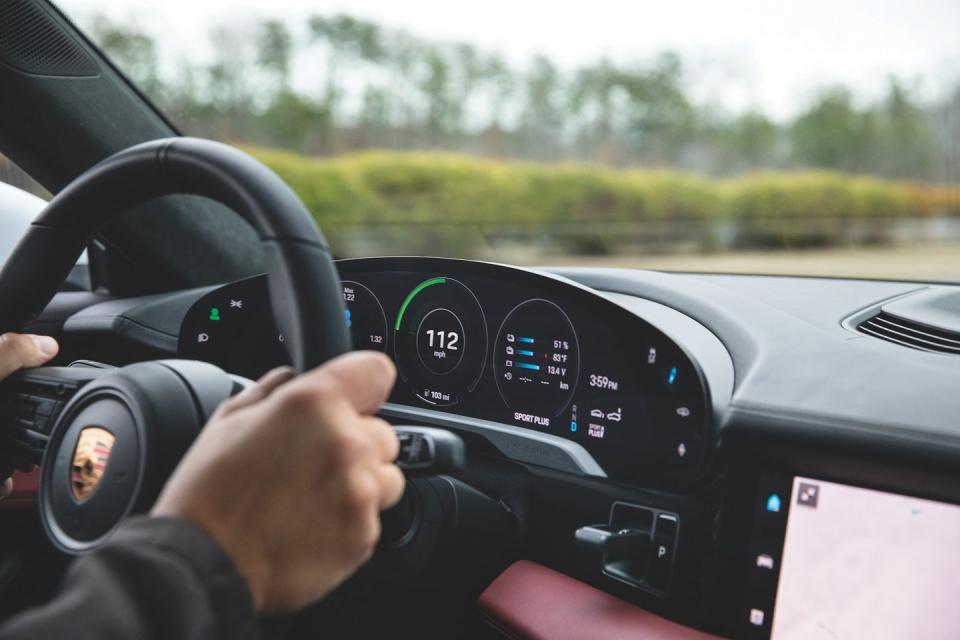
With no fuss, secret button-presses, or extended warm-up period required, the Turbo S can explode off the line within moments of switching on. The car’s 2.4-second sprint to 60 comes with zero drama, as the traction-control system is millisecond-precise. Immediately after the mile-a-minute mark, you feel a firm nudge as the rear transmission slam-shifts into its second and final gear. The nauseating acceleration then continues as the quarter-mile passes in just 10.5 seconds, at 130 mph. After that, the Taycan continues to hurtle silently toward its 161-mph top speed at an alarming rate. Earning its badge, the top-spec electric Porsche is quicker than even the most powerful 911 Turbo S in all tests up through 140 mph.
Like all electric cars, the Taycan feels an order of magnitude quicker in the real world than those numbers suggest. Because electric motors put out close to their peak power over a broad range of shaft speeds, they’re ready to explode forward at all times—squirting through vacant holes in traffic requires only a tap of the turn signal and a twitch of a toe. But the Taycan’s inclusion of a two-speed, single-clutch, decoupling automatic rear transaxle eliminates one of an electric car’s chief advantages: always being in the right gear. In Range mode, the Taycan decouples its rear motor from the wheels, the big sedan nominally driven by its front tires. Sudden throttle stabs mean the rear motor has to first connect again, a process that is reasonably quick but also marked with clunks and surges in acceleration. The fact that Porsche installed this transmission in the name of efficiency and then managed to produce the least-efficient mass-production EV on the market (see sidebar, "The Puzzling Logic of Porsche's First EV," at the bottom of this page) proves Germans do have a sense of humor.
Regardless of drive mode, the Taycan’s rear transmission isn’t nearly as smooth or as quick as Porsche’s PDK dual-clutch automatic. In Normal mode, the rear powertrain favors second gear, which means that large throttle inputs are occasionally met with far less violence than you expect. Sometimes, the transmission will slam back into first and rocket the car forward. Other times not. No other production EV has a multi-speed transmission, which means none of those cars suffer from such inconsistent response.
This is another great irony, given that Porsche has gone to great lengths to publicly flame Tesla for its cars’ inconsistent responses to battery heat-up. Stuttgart recently issued a press release announcing that the Taycan’s performance varied by just 0.8 seconds during 26 consecutive runs from a standstill to 124 mph. Only a German firm could engineer an EV for such an absurd fringe case, then ignore the massive inconsistency in response and acceleration encountered in the real world.
Transmission foibles aside, the Taycan is an incredibly smooth and quiet cruiser. There’s no wind noise, even at triple-digit speeds, just distant tire thrum and a whine from the drive motors. The steering is precise, perfectly weighted, and accurate, if numb, with zero surface texture or feedback. Ride quality is astonishingly supple, even with the adaptive dampers and air springs in their harshest settings. In normal driving, the car is simply too good at being a car to be a great Porsche—with no engine to interact with, no sensation of speed, and zero steering feel, it’s an isolation chamber verging on the dull.
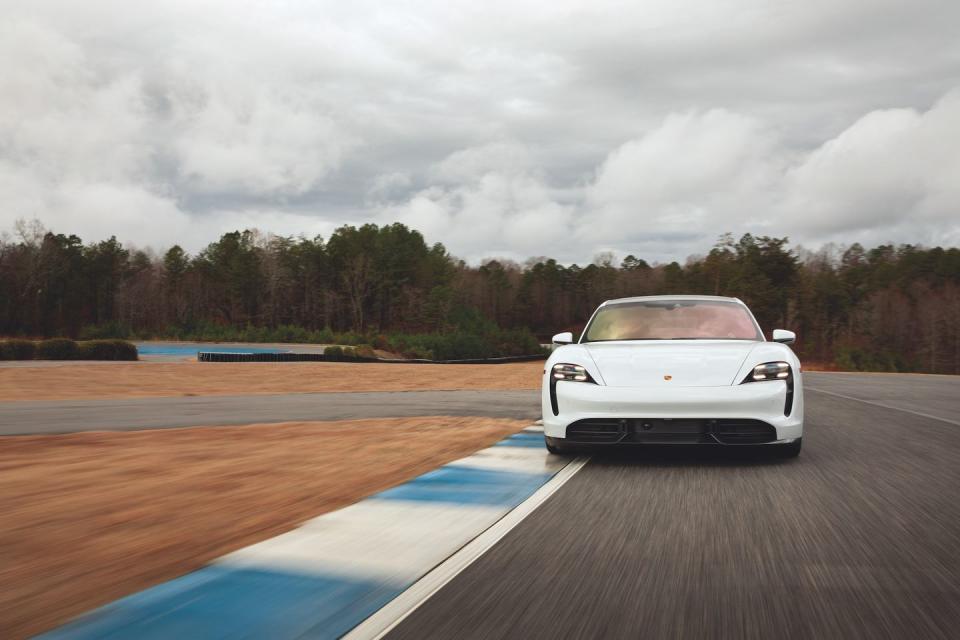
When the road turns into track, however, the Taycan turns into a Porsche. At our test facility for this story, the magnificent Atlanta Motorsports Park, the Taycan proved itself 100 percent worthy of the crest on its hood.
In addition to carrying 1389 pounds of its rather obscene 5246-pound curb weight under the floor in its battery pack, the Taycan has other tricks for staying composed in corners. Active anti-roll bars virtually eliminate body roll, and the massive Goodyear Eagle F1 Asymmetric 3 ultra-high-performance all-seasons (265-millimeter fronts, 305-millimeter rears—on par with a 911 Turbo S) provide tenacious grip and let go progressively and controllably.
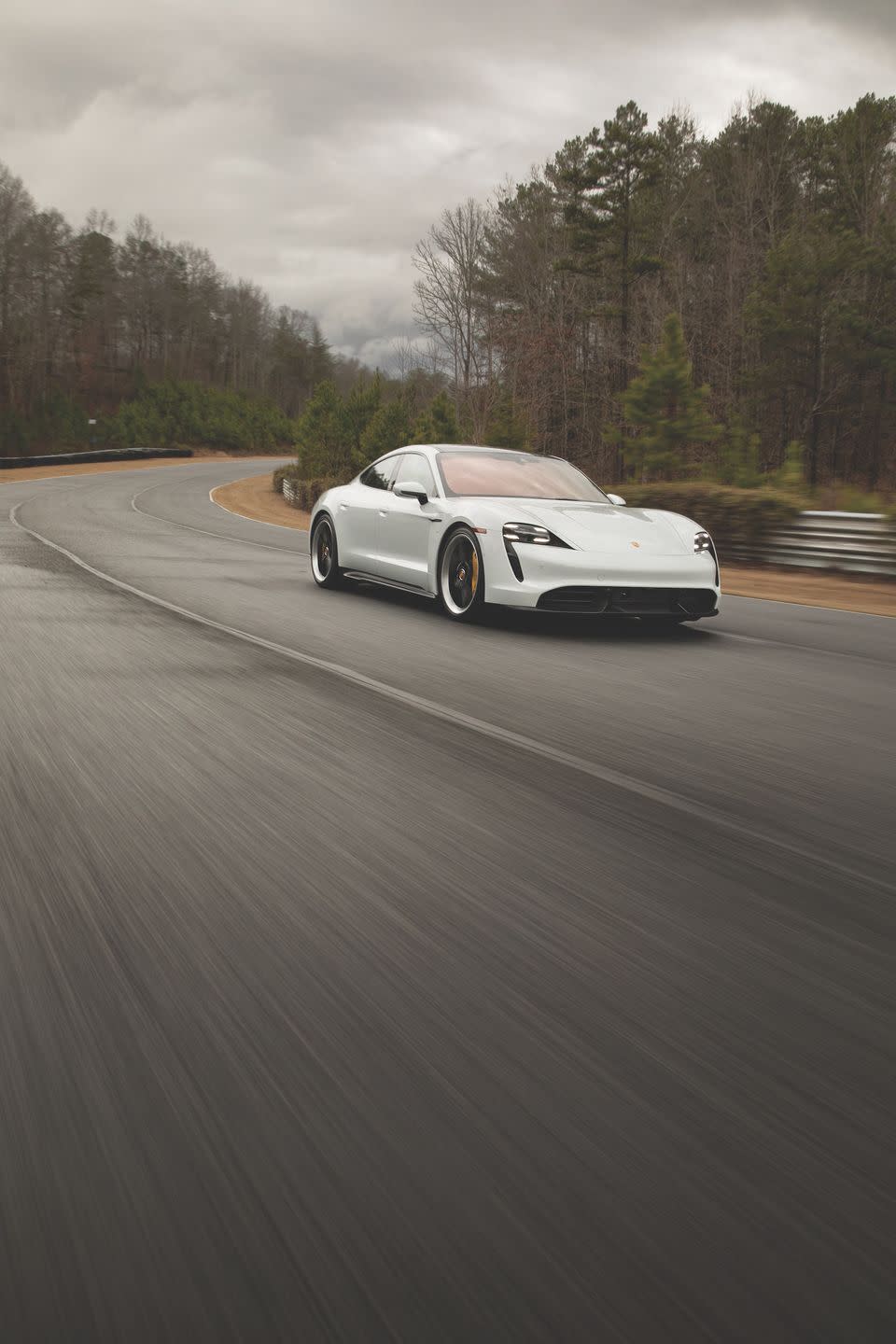
You don’t feel the limits approaching in the wheel, but you do hear those Goodyears singing their arrival. All four tires. Most corners produce gentle entry understeer that transitions into a neutral four-wheel slide, and the four-wheel steering is so well-tuned that you could spend a day lapping a racetrack without noticing its presence. Trailing throttle will tuck the Taycan’s nose, adding just a bit of power will settle it, and if you’re greedy with the electrons, this Porsche will hang its tail out in a glorious, easily controlled natural drift.
We’ve never been able to say that last bit about an electric car. Here’s another first: The Taycan S combines the balance and throttle adjustability of a good mid-engine sports car, like the 718 Cayman, with the ability to rocket out of a corner ass-first, like the rear-engine 911 Turbo S. Dynamically, it’s nothing short of magnificent.
The acceleration is so violent that every straight is an elongated pucker moment. Drifting to the edge of the pavement on Atlanta Motorsports Park’s crooked front straight at over 110 mph, the Taycan gathers speed as if in freefall. Crossing the finish line on the third lap, my Apple Watch displayed a congratulation for my workout. Heart rate: 160 beats per minute. Who says EVs can’t be exciting?
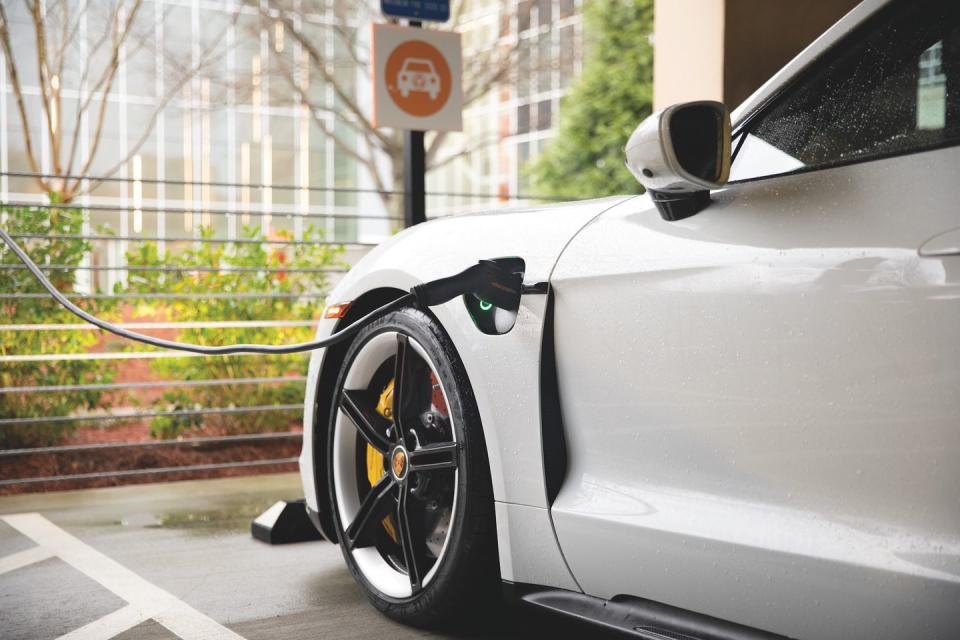
The Taycan’s big, well-cooled battery can accept up to 270 kW from a DC fast charger, or up to 265 kW as energy regenerated in slowing the car. The latter is the more impressive figure, because it means that up to 0.39 g of braking can be accomplished even before the enormous friction brakes under the left pedal get involved. On the street, the 16.5-inch front and 16.1-inch rear carbon-ceramic rotors and enormous calipers (10 pistons front, four in back) function mostly as decoration. On the track, their performance is breathtaking—and unlike most hybrids or EVs, the Taycan’s regenerative braking stays active even under ABS.
The system gives positive pedal feel, though travel does grow after a few laps. The pedal is blended—connected to an electronic booster that dynamically divides brake force between regen braking and friction brakes—but the only sign is that the brakes don’t release as quickly or smoothly as a traditional hydraulic system.
Power delivery was consistent during our admittedly brief hot-lapping session, with no sign of battery or motors heating to a point where the car would automatically reduce its output. Porsche’s stated 750-hp figure comes with a caveat; that number is possible only during activation of launch control, and then only for 2.5 seconds. In all other conditions, maximum power is 616 hp, and that amount is only available for 10 continuous seconds. The limitation is largely academic outside of an autobahn or a large track. (AMP is not small, but its 2.0-mile length gave no opportunity to be flat-out for that long in a car this fast.)
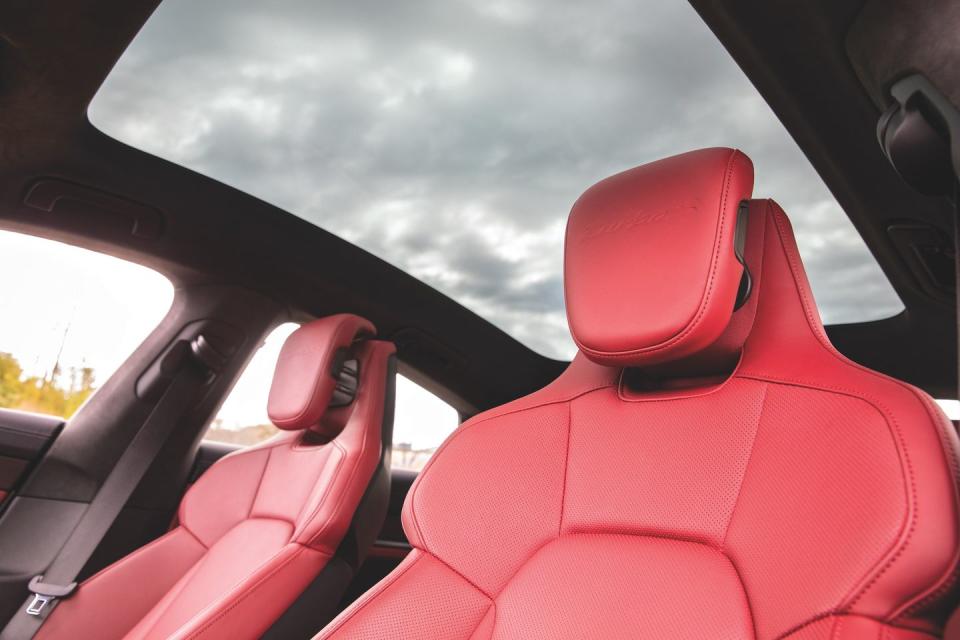
Despite keeping regen active during full braking, a condition that should provide a significant range benefit on track, our Turbo S blazed through an indicated 24 percent of its battery in an 11-mile lapping session. A testament to the fact that power always requires resources, whether gas or electric—in fewer than 15 minutes, the Porsche used almost as much energy as the average U.S. household does in an entire day. Without an ultra-high-output DC charger in the paddock, you’re probably not going to track a Taycan, and to the best of our knowledge, no track in America is currently so equipped.
Which brings us back to the car’s biggest problem: fringe-case engineering.
Unlike Teslas and every other EV in production, the Taycan does not offer a high-regen mode. This means there is no one-pedal driving for the street. Porsche says this choice was made partially because coasting is more efficient than regenerating and redeploying power—ironic, again, given the Taycan’s abysmal efficiency—and partially because an EV’s regen varies with battery charge and temperature.
In other words, Porsche wants the Taycan to behave consistently, unlike other EVs. Yet one more fantastic laugh, as that two-speed rear gearbox removes consistent acceleration response in real life.
The supposed efficiency benefits of that complex transmission are unlikely to pay dividends either, as spinning an electric motor quickly doesn’t require a lot of energy. We suspect the rear gearbox was included mostly for flat-out performance—Porsche likely wanted the Taycan to be able to keep up with Tesla’s Model S Performance at low speed (it doesn’t) and hand it a steaming can of German Whoop-Ass during high-speed autobahn drag races (it does, above 100 mph).
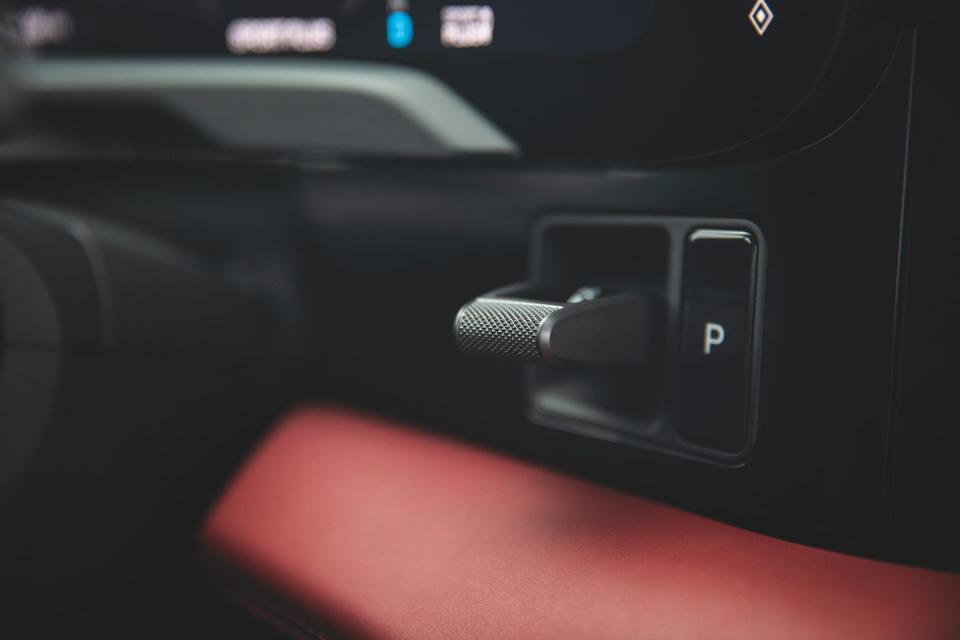
Unfortunately, that’s yet another use case irrelevant in the real world, or at least the world outside Germany. But even within the Fatherland, high-speed performance shouldn’t be a priority. Because charging takes so much time, long-distance EV trips are faster when you balance efficiency and speed, minimizing stops. Indeed, when Porsche set out to cover as many Taycan miles as possible in 24 hours last year, at its enormous Nardo proving-ground oval, the company had the car cruise 30-40 mph beneath its 161-mph tap-out.
Efficiency also determines max cruising speed. Porsche tried to get around that by using an 800-volt battery pack, double the typical voltage. In theory, this should allow for charging at twice the speed of a Tesla. The rub: Even if that were the case in practice (it’s not) and the Porsche could absorb energy at twice the rate of a Model S (it can’t), the Taycan wouldn’t be able to travel any farther than the Tesla because it consumes twice the energy to move. What matters to drivers is charging mph, miles of range added per hour of charging. And because the Taycan’s efficiency is so poor, it can barely match the Model S even at twice that car’s charge rate.
We owe the German automotive industry a lot—that culture’s stubborn insistence on bulletproof engineering essentially completed the development of the automobile. But we owe Tesla for taking the next step, considering those learnings while applying only those truly important to customers. Tesla’s greatest accomplishment wasn’t in proving that a Valley startup could build a car, or that the world was ready for EVs. The coup came in ignoring what ordinary drivers don’t notice (panel gaps, marginal build quality) and focusing on reality.
And where EVs are concerned, that means efficiency. A Model S probably can’t do 26 consistent, consecutive 0-to-124-mph runs, but Tesla was smart enough to recognize that its customers would never, ever do that. The Americans focused on what those people actually do, which is drive their cars long distance. As a result, the less complicated, less expensive, lighter, and more space-efficient Model S can travel up to 370 miles on a single charge—178 miles farther than a Taycan Turbo S.
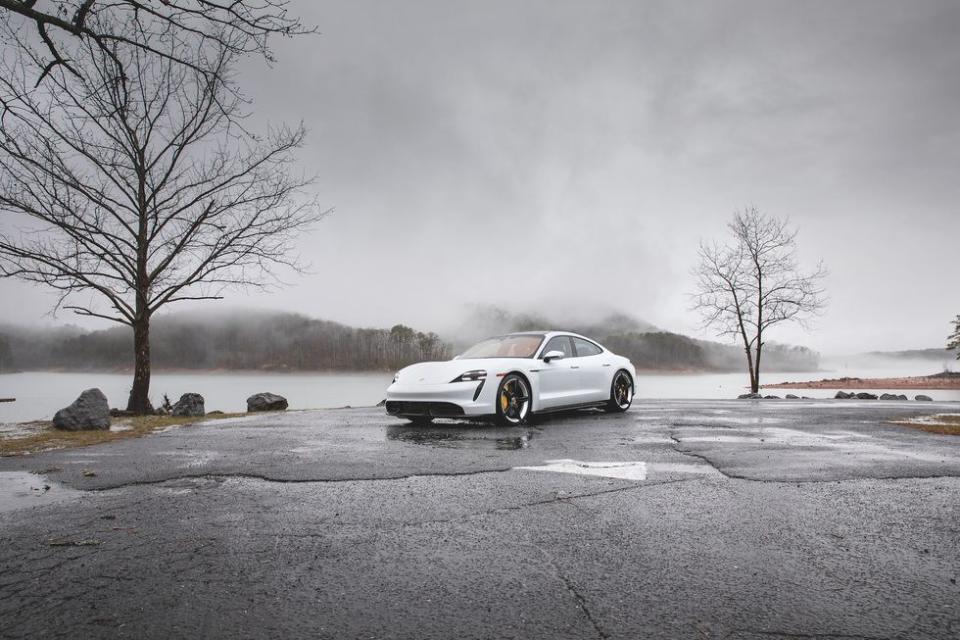
The very idea that Porsche exchanged 178 miles of real-world range for gains like eight-tenths of crazy-town consistency is just silly. Guess it’ll be Tesla laughing this round—at the Porsche drivers walking 178 miles home.
The Puzzling Logic of Porsche's First EV
In the infancy of electric cars, where charging is slow and public-charging infrastructure is incomplete, range is the only metric that matters. Every EV buyer has an imaginary minimum range they’ll accept when considering a new car. That number may not always be rational, but it exists. Think of it as an amusement-park sign saying, “You must be this tall to get on this ride.” And the Taycan just isn’t.
The Turbo S can travel an EPA-rated 192 miles on a charge, which is especially egregious considering the car’s enormous battery. At 93.4 kWh, that pack is one of the largest in the industry, even though Porsche’s software only allows for the use of 83.7 kWh, largely in the name of consistent performance and longevity. Alas, the short range comes from inefficiency. The Taycan Turbo S scored an EPA-rated 68 MPGe, earning it dubious distinction as the single most inefficient regular-production electric vehicle in history.
Efficiency is paramount in EVs because you can’t simply add battery capacity the way you can increase the size of an internal combustion car’s fuel tank—batteries weigh too much. Doubling the Taycan’s battery capacity would add nearly 1500 pounds, and then every other subsystem in the vehicle, from suspension to tires, would have to be upsized to compensate. That upsizing, in turn, adds more weight, resulting in even more inefficiency. It’s a case of diminishing returns, and doubling battery capacity doesn’t double range.
Tesla chose to focus on the e-word. The Model 3 now scores up to 141 MPGe, and the aging Model S lands 111 MPGe—or in the case of the latter’s performance model on 21-inch wheels, 97 MPGe. That’s a gain of almost 50 percent over a Taycan Turbo S, and the American car is quicker until you’re going fast enough to lose your license.
In our time with the Turbo S, the Porsche chewed electrons at a rate just under its EPA figures. The Taycan’s computer optimistically predicted 230 or more miles per charge no matter how we drove, but in moderate road testing, our average consumption equaled around 210 miles. This meant traveling with the bulk of traffic, ambient temperatures in the mid-60s, with the climate system in Auto Eco mode. That’s around 10 percent better than the EPA rating, and the Taycan does even better at highway speeds, no doubt thanks to its impressive 0.25 aerodynamic-drag coefficient. The car consumed far more energy at low speed, likely due to high tire rolling resistance and high power consumption from the onboard computers and battery management systems.
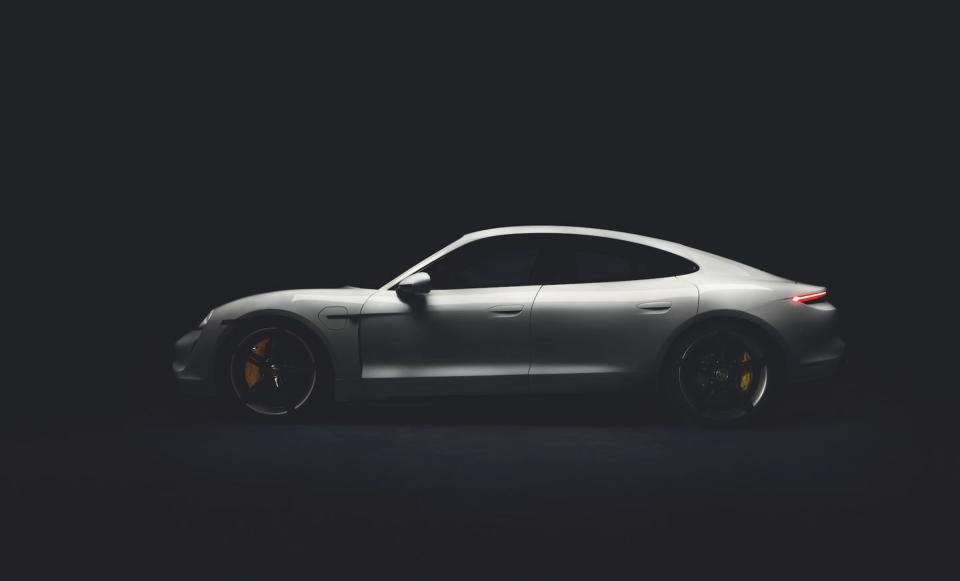
We don’t pan hypercars for using a lot of gasoline, but one of the biggest benefits of EVs is how their ability to accelerate has no impact on energy use in normal driving. Much of the Taycan is disappointingly inefficient: The car is heavier than we’d expect, it offers far less cabin and cargo space than its exterior size suggests, and it has an unnecessarily complex powertrain. Porsche would likely have been better off paying attention to the type of performance its customers will actually use.
You Might Also Like

 Yahoo Autos
Yahoo Autos 